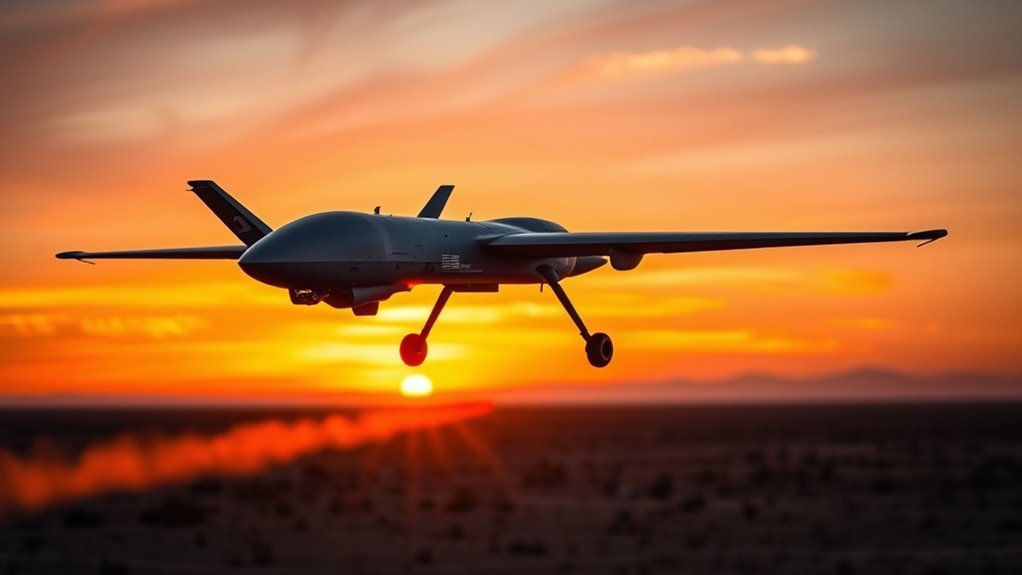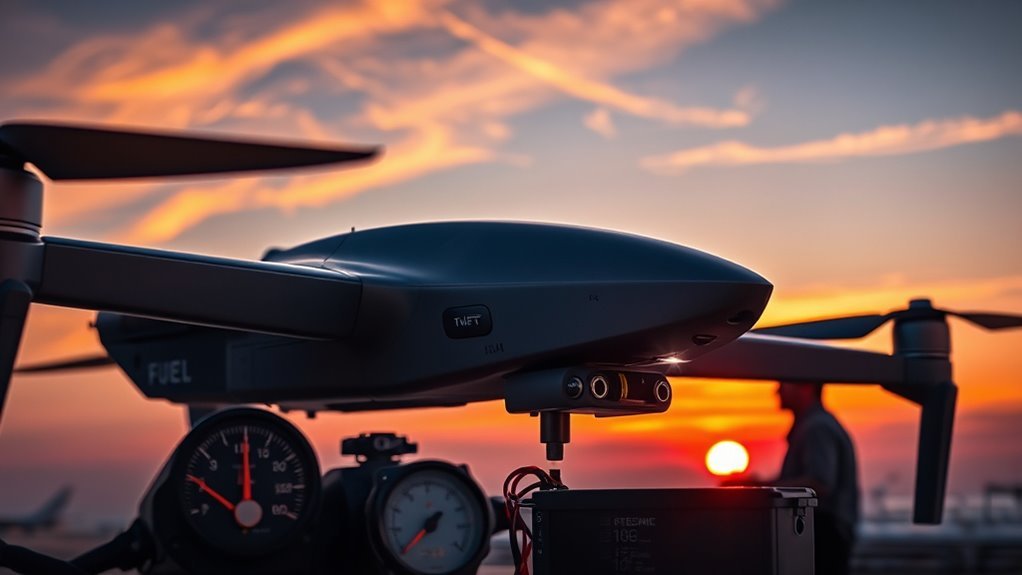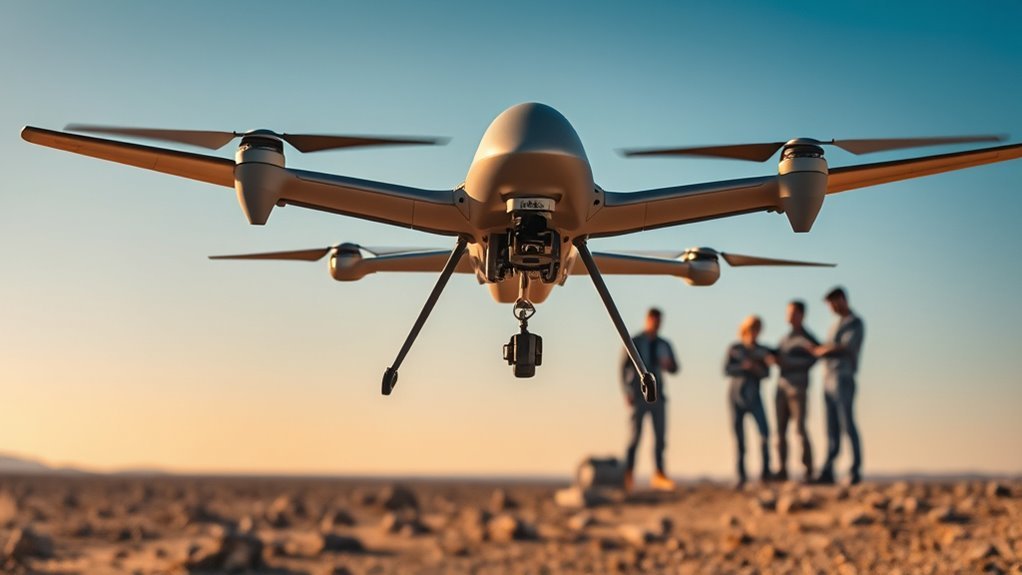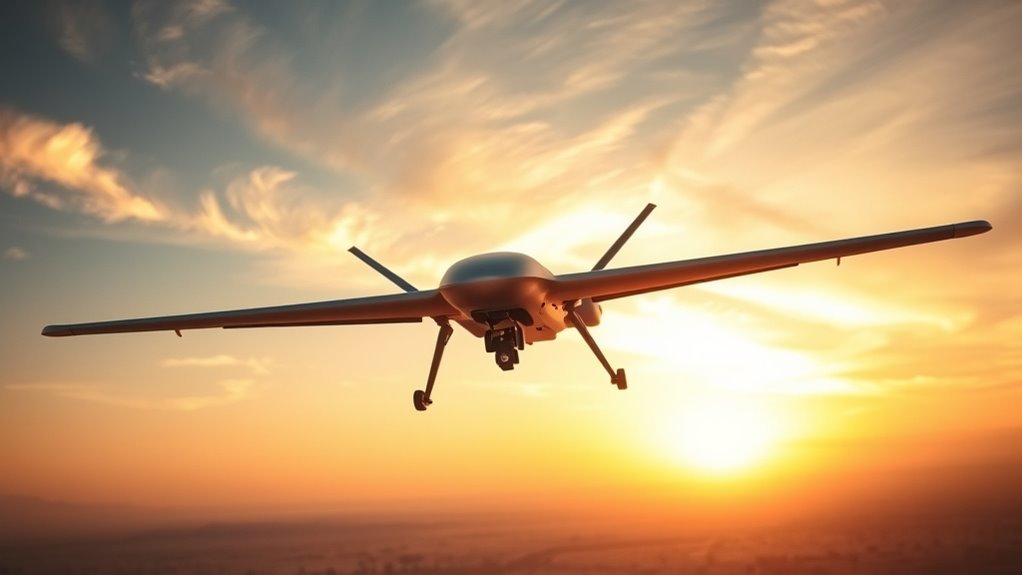Flight duration of military drones hinges on several factors. Key aspects include drone design and aerodynamics, fuel type and capacity, and payload weight. Engine performance and efficiency also play critical roles. Environmental conditions, like weather and altitude, affect flight capabilities. Additionally, mission profiles and requirements dictate operational strategies, while technological advancements enhance capabilities. Maintenance and operational readiness guarantee mission effectiveness. Understanding these dynamics reveals how they intertwine to optimize flight duration and performance.
Drone Design and Aerodynamics

When considering drone design and aerodynamics, it’s essential to understand how each component influences flight duration and overall performance. The choice of drone materials plays a significant role; lightweight composites enhance maneuverability while reducing energy consumption. These materials should also withstand environmental stresses, ensuring durability in various conditions. Aerodynamic shapes are equally important; streamlined designs minimize drag, allowing for more efficient flight paths. Features like wing shape and fuselage contours can drastically affect airflow, promoting stability and reducing turbulence. By optimizing these aspects, you can enhance the drone’s range and operational capabilities. Additionally, advanced camera capabilities such as sophisticated image stabilization can contribute to the overall efficiency of drone operations. Ultimately, a thorough understanding of how materials and shapes interact will empower you to design drones that fulfill precise mission requirements while maximizing freedom in the air. Additionally, drones like the Anzu Raptor demonstrate how NDAA compliance can influence design choices and operational performance for military applications.
Fuel Type and Capacity

The design and aerodynamics of a drone directly influence its fuel type and capacity, factors that are vital for optimizing flight duration. You need to take into account how fuel efficiency plays a significant role in extending flight times, especially when mission requirements escalate. Traditional fuel types may limit operational range, but innovative fuel alternatives are emerging, promising greater endurance.
| Fuel Type | Advantages |
|---|---|
| Gasoline | High energy density |
| Biofuels | Environmentally friendly |
| Batteries | Low emissions |
Payload Weight and Its Impact

While considering the flight duration of military drones, payload weight plays a essential role in determining performance and efficiency. Heavier payloads can greatly reduce flight time, as they demand more energy for lift and maneuverability. Achieving ideal payload optimization is fundamental; effective weight distribution guarantees that the drone can maintain stability while maximizing its operational capabilities. By carefully balancing the load, you can improve endurance and extend mission duration. Additionally, understanding the trade-offs between payload capacity and flight performance is critical. Each mission may necessitate different configurations, so it’s important to assess how payload weight impacts overall efficiency. Ultimately, optimizing payload weight is key to enhancing your drone’s effectiveness in achieving strategic objectives. Moreover, motor power directly influences a drone’s ability to sustain heavy loads while maintaining flight stability.
Engine Efficiency and Performance
In evaluating engine efficiency and performance, you’ll need to take into account the fuel consumption rate, which directly impacts flight duration. Variability in engine types can also play a critical role, as different designs may optimize propulsion systems differently. Understanding these factors is essential for maximizing the operational capabilities of military drones.
Fuel Consumption Rate
Understanding fuel consumption rates in military drones is essential for optimizing flight duration and operational efficiency. By conducting a thorough consumption analysis, you can identify factors affecting fuel efficiency, such as payload weight, flight speed, and altitude. High fuel consumption not only limits range but also impacts mission effectiveness. Engineers often focus on improving engine design to enhance performance, thereby reducing the overall fuel needed for extended operations. Additionally, understanding aerodynamic drag and optimizing flight paths can lead to significant improvements in fuel efficiency. When you grasp these elements, you’ll be better equipped to evaluate a drone’s operational capabilities and make informed decisions about mission planning and resource allocation, ultimately maximizing the potential of your aerial assets.
Engine Type Variability
As advancements in drone technology continue to evolve, the variability in engine types greatly influences both efficiency and performance. Different engine types, such as piston engines, turbojets, and turbofans, exhibit distinct characteristics that affect performance metrics like thrust-to-weight ratios and fuel consumption. Each engine type not only determines the operational range but also impacts the drone’s ability to sustain prolonged missions. For instance, a turbojet might offer superior speed but at the cost of higher fuel consumption, whereas a piston engine may excel in efficiency at lower speeds. Understanding these differences allows you to make informed decisions on the ideal engine type tailored to specific mission parameters, ultimately optimizing drone performance and flight duration.
Propulsion System Design
Effective propulsion system design is vital for optimizing engine efficiency and performance in military drones. You’ll find that propulsion innovation plays an essential role in extending flight duration and enhancing operational capabilities. However, engineers face significant design challenges, including weight constraints, fuel efficiency, and thermal management. By focusing on aerodynamics and advanced materials, you can improve thrust-to-weight ratios and reduce drag, thereby maximizing endurance. Furthermore, integrating hybrid systems or alternative fuels can further enhance efficiency while addressing environmental concerns. Ultimately, a well-designed propulsion system not only guarantees longer flight times but also provides the versatility needed for various missions. Embracing these innovations will empower military drones to achieve their full potential in the field.
Environmental Factors
When analyzing military drones’ flight duration, it’s essential to take into account environmental factors like weather conditions, altitude, and air density. These elements directly impact aerodynamic efficiency and fuel consumption, which can greatly alter operational capabilities. Understanding their effects allows for more accurate predictions of flight performance in varying scenarios.
Weather Conditions
Although weather conditions may seem like a secondary consideration, they considerably impact the flight duration of military drones. Factors like wind speed, precipitation, and temperature play essential roles in determining operational efficiency. High winds can increase drag, requiring more energy and reducing flight time. Rain introduces additional weight and can impair sensor functionality, further complicating missions. Extreme temperatures affect battery performance, with both high and low conditions potentially shortening flight capacity. Understanding these atmospheric conditions is critical for mission planning; ignoring the weather impact could lead to unanticipated failures or shortened missions. For effective drone operation, you must consider these elements to guarantee peak performance and maximize the duration of your flight missions.
Altitude and Air Density
Altitude substantially influences the flight duration of military drones due to its direct impact on air density. As altitude increases, air density decreases, which can affect drone performance in several ways:
- Lift Generation: Reduced air density means less lift, requiring more power for the drone to maintain altitude.
- Battery Efficiency: Higher altitudes can strain battery life since motors have to work harder, impacting overall flight time.
- Control and Stability: Lower air density can compromise control surfaces, leading to less maneuverability and stability.
Understanding these altitude effects is essential for optimizing drone operations. By analyzing how air density fluctuates with altitude, you can better predict and enhance military drone flight durations, ensuring they perform effectively in various environments.
Mission Profile and Requirements
As military operations evolve, understanding the mission profile and requirements for drone flights becomes vital. You need to take into account mission objectives, which dictate the specific tasks drones must accomplish, such as surveillance, reconnaissance, or strike capabilities. Each of these objectives imposes distinct operational constraints that can affect flight duration. For instance, a long-range surveillance mission may require extended loitering times, while strike missions necessitate rapid deployment and return. Additionally, environmental factors, aircraft design, and payload weight play significant roles in how long a drone can remain airborne. By analyzing these elements, you can optimize flight plans to guarantee that military drones meet their objectives efficiently while adhering to necessary constraints, maximizing operational effectiveness.
Technological Advancements in UAVs
With advancements in technology, the capabilities of unmanned aerial vehicles (UAVs) have markedly improved, enhancing their effectiveness in military operations. Key developments include:
- Autonomous Navigation: UAVs now utilize sophisticated algorithms, allowing them to navigate complex environments without human intervention, thereby increasing mission efficiency. This technology reflects the importance of automated processes in optimizing operational workflows.
- Sensor Integration: Enhanced sensor technologies enable real-time data collection and analysis. This integration allows for better situational awareness and target identification.
- Extended Flight Times: Innovative power management systems and lightweight materials contribute to longer operational durations, providing strategic advantages during missions. Additionally, advancements in thermal imaging technology improve UAVs’ ability to detect heat signatures, further enhancing their operational capabilities in various environments.
These technological advancements not only bolster the operational capabilities of UAVs but also address the growing demands for precision and flexibility in modern warfare, ultimately ensuring greater freedom in military operations.
Maintenance and Operational Readiness
While the advanced capabilities of UAVs markedly enhance their operational effectiveness, maintaining these systems is essential for guaranteeing their readiness in the field. Effective maintenance protocols are vital; they involve routine inspections, software updates, and component replacements. You need to establish a regular schedule to prevent unexpected failures that could compromise missions. Additionally, integrating operational strategies that prioritize maintenance can optimize flight duration and reliability. This might include employing predictive analytics to forecast potential issues before they arise, allowing for proactive interventions. By focusing on both maintenance protocols and operational strategies, you can guarantee your drones remain mission-ready, maximizing their potential and extending their flight durations in critical situations. Proper maintenance not only safeguards your investment but also maintains operational freedom. Moreover, understanding flight endurance can aid in better planning and management of drone usage during missions. Furthermore, maintaining high-resolution sensors ensures precise data collection, enhancing overall mission effectiveness.
Strategic Implications of Flight Duration
Effective maintenance not only guarantees operational readiness but also greatly influences the strategic implications of flight duration for military drones. Understanding this relationship can provide significant advantages in various scenarios. Here are three key strategic implications:
- Extended Surveillance: Longer flight durations enhance your ability to monitor vast areas, providing vital intelligence without the need for frequent returns to base.
- Rapid Response Capability: Increased flight time allows for quicker engagement in dynamic situations, offering tactical flexibility that can change the course of operations.
- Resource Optimization: Prolonged missions can reduce the frequency of launches, conserving both time and operational resources while maximizing impact. Additionally, drone regulations in various regions can affect operational strategies, highlighting the importance of compliance in military operations.
Frequently Asked Questions
How Do Weather Conditions Affect Drone Flight Time?
Weather conditions substantially impact your drone’s flight time. Wind resistance can reduce efficiency, while temperature fluctuations may affect battery performance, ultimately limiting how long you can operate your drone effectively in varying environmental conditions.
What Role Does Pilot Experience Play in Flight Duration?
Pilot experience levels greatly influence flight duration. With robust pilot training, seasoned operators can optimize drone performance, manage fuel effectively, and adapt to changing conditions, ultimately extending operational time and enhancing mission success.
Can Drones Be Refueled Mid-Mission?
Yes, mid-mission refueling can enhance drone endurance considerably. By utilizing aerial refueling techniques, you can extend operational capabilities, allowing drones to remain airborne longer without the need for a return to base, optimizing mission effectiveness.
How Does the Terrain Influence Drone Performance?
Isn’t it fascinating how terrain challenges can dramatically affect your drone’s performance? Altitude effects, like reduced lift and battery efficiency, can hinder operations, necessitating careful planning to guarantee mission success in varying landscapes.
What Regulations Impact Drone Flight Time?
You’ll find that regulations considerably impact drone flight time. Regulatory compliance often dictates flight restrictions, limiting operational hours and altitude, which can ultimately constrain your mission’s effectiveness and flexibility in diverse environments.

